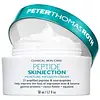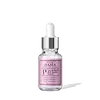What's inside
What's inside
 Key Ingredients
Key Ingredients

 Benefits
Benefits

 Concerns
Concerns

 Ingredients Side-by-side
Ingredients Side-by-side

Water
Skin ConditioningGlycerin
HumectantDimethicone
EmollientOlive Oil Decyl Esters
Glycereth-26
HumectantSqualane
EmollientButylene Glycol
HumectantBehenyl Alcohol
EmollientPolysilicone-11
Batyl Alcohol
EmollientSimmondsia Chinensis Seed Oil
EmollientHexapeptide-11
Skin ConditioningDipeptide Diaminobutyroyl Benzylamide Diacetate
Skin ConditioningPalmitoyl Tripeptide-5
Skin ConditioningTripeptide-10 Citrulline
Skin ConditioningAcetyl Hexapeptide-1
Skin ConditioningAcetyl Tetrapeptide-11
Skin ConditioningAcetyl Hexapeptide-8
HumectantPalmitoyl Hexapeptide-12
Skin ConditioningAcetyl Tetrapeptide-9
Skin ConditioningPalmitoyl Tetrapeptide-7
Skin ConditioningAcetyl Tetrapeptide-2
Skin ConditioningAcetyl Octapeptide-3
HumectantPalmitoyl Hexapeptide-19
Skin ConditioningTrifluoroacetyl Tripeptide-2
Skin ConditioningTripeptide-1
Skin ConditioningPalmitoyl Oligopeptide
CleansingPalmitoyl Tripeptide-1
Skin ConditioningNatto Gum
Sodium Polyglutamate
HumectantSqualene
EmollientMica
Cosmetic ColorantSodium Hyaluronate
HumectantSorbic Acid
PreservativeTocopherol
AntioxidantCereus Grandiflorus Flower Extract
Skin ConditioningPseudoalteromonas Ferment Extract
HumectantLeuconostoc/Radish Root Ferment Filtrate
AntimicrobialMagnesium Chloride
Phenoxyethanol
PreservativeCetyl Alcohol
EmollientStearyl Alcohol
EmollientTrehalose
HumectantGlyceryl Stearate
EmollientSilanetriol Trehalose Ether
EmollientMannitol
HumectantPhytosterols
Skin ConditioningAcrylates/C10-30 Alkyl Acrylate Crosspolymer
Emulsion StabilisingCaprylic/Capric Triglyceride
MaskingHydrogenated Lecithin
EmulsifyingPolyglyceryl-10 Myristate
Skin ConditioningPolysorbate 20
EmulsifyingDimethyl Isosorbide
SolventSodium Benzoate
MaskingPotassium Sorbate
PreservativeCaprylyl Glycol
EmollientSodium Hydroxide
BufferingLaureth-12
EmulsifyingHydrolyzed Wheat Protein
Skin ConditioningLecithin
EmollientDisodium Phosphate
BufferingHydrolyzed Soy Protein
HumectantCarbomer
Emulsion StabilisingDextran
Ethylhexylglycerin
Skin ConditioningSodium Lactate
BufferingTetradecyl Aminobutyroylvalylaminobutyric Urea Trifluoroacetate
Skin ConditioningSodium Phosphate
BufferingXanthan Gum
EmulsifyingTriethanolamine
BufferingAcrylates Copolymer
Water, Glycerin, Dimethicone, Olive Oil Decyl Esters, Glycereth-26, Squalane, Butylene Glycol, Behenyl Alcohol, Polysilicone-11, Batyl Alcohol, Simmondsia Chinensis Seed Oil, Hexapeptide-11, Dipeptide Diaminobutyroyl Benzylamide Diacetate, Palmitoyl Tripeptide-5, Tripeptide-10 Citrulline, Acetyl Hexapeptide-1, Acetyl Tetrapeptide-11, Acetyl Hexapeptide-8, Palmitoyl Hexapeptide-12, Acetyl Tetrapeptide-9, Palmitoyl Tetrapeptide-7, Acetyl Tetrapeptide-2, Acetyl Octapeptide-3, Palmitoyl Hexapeptide-19, Trifluoroacetyl Tripeptide-2, Tripeptide-1, Palmitoyl Oligopeptide, Palmitoyl Tripeptide-1, Natto Gum, Sodium Polyglutamate, Squalene, Mica, Sodium Hyaluronate, Sorbic Acid, Tocopherol, Cereus Grandiflorus Flower Extract, Pseudoalteromonas Ferment Extract, Leuconostoc/Radish Root Ferment Filtrate, Magnesium Chloride, Phenoxyethanol, Cetyl Alcohol, Stearyl Alcohol, Trehalose, Glyceryl Stearate, Silanetriol Trehalose Ether, Mannitol, Phytosterols, Acrylates/C10-30 Alkyl Acrylate Crosspolymer, Caprylic/Capric Triglyceride, Hydrogenated Lecithin, Polyglyceryl-10 Myristate, Polysorbate 20, Dimethyl Isosorbide, Sodium Benzoate, Potassium Sorbate, Caprylyl Glycol, Sodium Hydroxide, Laureth-12, Hydrolyzed Wheat Protein, Lecithin, Disodium Phosphate, Hydrolyzed Soy Protein, Carbomer, Dextran, Ethylhexylglycerin, Sodium Lactate, Tetradecyl Aminobutyroylvalylaminobutyric Urea Trifluoroacetate, Sodium Phosphate, Xanthan Gum, Triethanolamine, Acrylates Copolymer
Aloe Barbadensis Leaf Extract
EmollientPropanediol
SolventGlycerin
HumectantPalmitoyl Tripeptide-1
Skin ConditioningPalmitoyl Tetrapeptide-7
Skin ConditioningAcetyl Hexapeptide-8
HumectantNiacinamide
Smoothing1,2-Hexanediol
Skin ConditioningSodium Hyaluronate
HumectantBeta-Glucan
Skin ConditioningAdenosine
Skin ConditioningButylene Glycol
HumectantAllantoin
Skin ConditioningRosa Damascena Extract
MaskingLavandula Angustifolia Flower Extract
CleansingCamellia Sinensis Leaf Extract
AntimicrobialMelissa Officinalis Leaf Extract
Skin ConditioningArtemisia Vulgaris Extract
Skin ConditioningAloe Barbadensis Leaf Extract, Propanediol, Glycerin, Palmitoyl Tripeptide-1, Palmitoyl Tetrapeptide-7, Acetyl Hexapeptide-8, Niacinamide, 1,2-Hexanediol, Sodium Hyaluronate, Beta-Glucan, Adenosine, Butylene Glycol, Allantoin, Rosa Damascena Extract, Lavandula Angustifolia Flower Extract, Camellia Sinensis Leaf Extract, Melissa Officinalis Leaf Extract, Artemisia Vulgaris Extract
Ingredients Explained
These ingredients are found in both products.
Ingredients higher up in an ingredient list are typically present in a larger amount.
Acetyl Hexapeptide-8, commonly known as Argireline or Acetyl Hexapeptide-3, is a popular peptide in skincare. It’s often referred to as a “Botox-like” ingredient because it helps reduce muscle movement.
By relaxing these micro-movements, Argireline may help minimize the appearance of fine lines and wrinkles. That said, it’s not as powerful as Botox, and research on its long-term effectiveness is still limited.
Beyond smoothing, Argireline may also support collagen production. Collagen is the protein that helps keep your skin firm, bouncy, and well-hydrated by strengthening the skin barrier.
So while Argireline isn’t a miracle fix, it can be a helpful addition to a routine focused on both prevention and skin health.
Read more about other common types of peptides here:
Learn more about Acetyl Hexapeptide-8Butylene Glycol (or BG) is used within cosmetic products for a few different reasons:
Overall, Butylene Glycol is a safe and well-rounded ingredient that works well with other ingredients.
Though this ingredient works well with most skin types, some people with sensitive skin may experience a reaction such as allergic rashes, closed comedones, or itchiness.
Learn more about Butylene GlycolGlycerin is already naturally found in your skin. It helps moisturize and protect your skin.
A study from 2016 found glycerin to be more effective as a humectant than AHAs and hyaluronic acid.
As a humectant, it helps the skin stay hydrated by pulling moisture to your skin. The low molecular weight of glycerin allows it to pull moisture into the deeper layers of your skin.
Hydrated skin improves your skin barrier; Your skin barrier helps protect against irritants and bacteria.
Glycerin has also been found to have antimicrobial and antiviral properties. Due to these properties, glycerin is often used in wound and burn treatments.
In cosmetics, glycerin is usually derived from plants such as soybean or palm. However, it can also be sourced from animals, such as tallow or animal fat.
This ingredient is organic, colorless, odorless, and non-toxic.
Glycerin is the name for this ingredient in American English. British English uses Glycerol/Glycerine.
Learn more about GlycerinPalmitoyl Tetrapeptide-7 (formerly Palmitoyl Tetrapeptide-3) is a lab-made peptide with anti-inflammatory and skin-repairing benefits. It's made up of four amino acids (glycine, glutamine, proline, and arginine) and palmitic acid (which helps it penetrate skin more effectively).
This ingredient helps reduce inflammation by limiting the production of interleukin-6 (IL-6), a chemical that triggers inflammatory responses, particularly after UV exposure.
Less inflammation = slower collagen breakdown and a longer-lasting, youthful appearance.
Palmitoyl Tetrapeptide-7 also stimulates collagen production and supports a healthier skin barrier.
Over time, this can improve skin firmness, hydration, and reduce the appearance of fine lines. It’s commonly paired with Palmitoyl Tripeptide-1 in the well-known Matrixyl 3000 complex for enhanced anti-aging effects.
This ingredient has been shown to be effective and safe in cosmetic use and you'll typically find it in small amounts (less than 0.01%).
Due to its palmitic acid base, it may not be safe for Malassezia folliculitis.
Read more about other common types of peptides here:
Learn more about Palmitoyl Tetrapeptide-7Palmitoyl Tripeptide-1 is also known as pal-GHK. It is made up of 3 amino acids and palmitic acid, a fatty acid that helps it absorb into skin more easily.
This peptide is as a signal peptide, meaning it tells the skin to produce more collagen. Collagen is the key protein that helps form the skin's structure and keep it plump, firm, and hydrated.
By boosting collagen production, this ingredient supports a stronger skin barrier and helps reduce the appearance of wrinkles.
You'll most likely see this ingredient paired with Palmitoyl Tetrapeptide-7 in the well-known Matrixyl 3000 complex. While results from in-house testing should be viewed cautiously, this peptide duo is among the most studied and widely used in modern skincare.
Due to its palmitic acid base, this ingredient may not be safe for Malassezia folliculitis.
Read more about other common types of peptides here:
Learn more about Palmitoyl Tripeptide-1Sodium Hyaluronate is hyaluronic acid's salt form. It is commonly derived from the sodium salt of hyaluronic acid.
Like hyaluronic acid, it is great at holding water and acts as a humectant. This makes it a great skin hydrating ingredient.
Sodium Hyaluronate is naturally occurring in our bodies and is mostly found in eye fluid and joints.
These are some other common types of Hyaluronic Acid:
Learn more about Sodium Hyaluronate